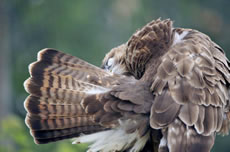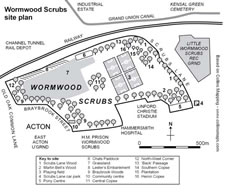Bird of the Month is a Buzzard on the Scrubs
As large raptors overtake kestrels
June 2010 Sightings at Wormwood Scrubs
Mid-summer quietness.
Bird of the month was undoubtedly the Common Buzzard that sailed through during the middle of the month. This large raptor is enjoying a massive range expansion in this country and has now taken the Kestrel’s mantle as the most common bird of prey in Britain. Their spread into London has been very apparent and it’s a species that we expect to be noticing over the skies of Wormwood Scrubs with more regularity in the future.
Other notables included a solo migrant Swallow and our first House Martin and Common Tern for the year. Our breeding birds were settled in and we recorded our first ever Willow Warbler family. The Reed Bunting pair that had chosen to nest in the grassland appeared to be getting down to business, although no fledglings were seen.
The annual mid-summer hiatus hit during June. There were few birds to be seen and even fewer birders. As usual for this time of year the paucity of records was a real concern. Many of our commoner species were barely mentioned let alone counted.
All is not lost though, as once July hits The Scrubbers return in anticipation of some interesting early returning migrants such as a wandering warbler or errant wader.
July to us is the start of the autumn and all the wonders that that wonderful season brings.
For us, summer has nearly passed. Exciting autumn starts soon.
Contributors: Rob Ayers, Mathew Bournat, Charlie Farrell, Nick Gibson, Penny Hayhurst, David Jeffreys, David Lindo, Roy Nuttall, Anders Price, Robert Stills et al.
Cormorant
The usual slim pickings were had with the peak excitement being 3 birds on the 10t and 28th. On the 21st, one was seen flying exceedingly low over the football pitches.
Grey Heron
A lone bird headed north on the 29th.
Canada Goose
A few were heard and seen during the month.
Common Buzzard
Our 2nd buzzard for the year drifted over on the 14th heading east towards the prison.
Sparrowhawk
A female was often seen visiting Lester’s Embankment on hunting missions.
Males are much less frequently seen as they normally do most of the woodland hunting. Woods of course are not a big feature at The Scrubs, so one flying into Central Copse on the 22nd was a treat.
Kestrel
A lone bird was watched hunting low over the grassland on the 10th. It or another was seen circling over towards the prison on the afternoon of 20th.
Black-headed Gull
The first of the returning birds began to appear in earnest from at least the 20th when two sub-adult birds frequented the football pitches. Drips and drabs were seen thereafter.
Herring Gull
The usual small congregations were seen either heading over or on the pitches.
Lesser Black-back
Around 10 were seen on the 21st.
Common Tern
This graceful seabird that has taken to urban living like a duck to water. Our first spring sighting of was on the 6th when one overflew the football pitches.
Last year, we saw our first bird on the 31st July – a late date but probably due no Scrubbers being at The Scrubs at the right times earlier on in spring to have noticed them. To put it all into context, we normally expect to see ourfirst birds during late April/early May.
Stock Dove
Strangely, after being seen sparingly throughout the year, at least 11 birds were feeding on the football pitches on the 8th. On the 22nd, our biggest terrestrial gathering occurred when at least 40 birds including juveniles were counted feeding with Wood Pigeons on the pitches. We noticed that some of the grass had been left to seed plus there were bare areas. No doubt a double attraction for the birds.
Larger than normal numbers were still to be found for the remainder of the month including an impressive 35 on the 29th, a gathering that even outnumbered the attendant Wood Pigeons.
Wood Pigeon
Juveniles were beginning to make an appearance on the scene with at least 25 birds noted on the 8th. At least 40 birds were counted on the 29th.
Swift
Small numbers were seen drifting over during the month with a maximum of 25 on the 29th.
Rose-ringed Parakeet
At least 50 birds were noticed on the 29th.
Green Woodpecker
One was recorded on the 21st.
Great Spotted Woodpecker
The odd bird was seen during the month.
Swallow
A late migrant flew through low across the football pitches and grassland on the 17th.
House Martin
Our first for the spring headed over on its own on the 8th. This swallow is a fairly scarce bird at The Scrubs at the best of times.
Meadow Pipit
June is always a quiet month for this classic little brown job. At least 7 birds were noted on the 17th. Birds were seen chasing each other around quite a bit but it was impossible to ascertain whether they were juveniles chasing adults, juveniles chasing juveniles or adults chasing adults. Towards the end of the month a couple males were noticed in song flight.
Pied Wagtail
Our breeding pair were busy gathering sustenance for their growing nestlings and were often seen on the pitches along the northern edge of our patch. A pair with a juvenile was seen on the 17th and probably the same family party contained 2 juveniles on the 21st.
Wren
Although plenty were seen during the month, unfortunately nobody submitted counts.
Dunnock
This is yet another common species for which no counts were received for this month.
Robin
A minimum of 10 birds was seen on a daily basis including several juveniles.
Song Thrush
With birds busily raising families numbers were hard to estimate. For instance, only 5 could be counted on the 29th while the real figure must have been at least treble that.
Mistle Thrush
A singleton was reported on the 18th.
Blackbird
At least 20 birds were noted throughout the month including juveniles.
Blackcap
A minimum of 10 were counted on the 29th including several youngsters.
Lesser Whitethroat
June is the month when these handsome birds slink undercover thus there was only one confirmed record of male singing briefly from Central Copse on the 21st.
Common Whitethroat
Perhaps 20 birds were at large including a lot of juveniles.
Chiffchaff
At least 7 birds were still singing up and down the park. Juveniles were also seen in good number.
Willow Warbler
At last we recorded our first confirmed breeding record on the 22nd when a small family party was noticed in the plantation south of Heron Copse.
Great Tit
Juveniles abounded during the month with most birds seen being youngsters. At least 15 were counted on the 29th.
Blue Tit
A minimum of 20 juveniles was seen on the 29th.
Long-tailed Tit
Only a few were noticed this month.
Magpie
Around 25 were around during the month.
Jay
A singleton was noticed on the 28th and heard from Scrubs Lane Wood the following day.
Carrion Crow
The peak count was 130 on the 29th.
Starling
A flock of 40 youngsters resided in the grassland during the month.
House Sparrow
The usual few were seen around their usual haunts around Braybrook Street during the month.
Chaffinch
Several birds were around during the month.
Linnet
Our breeding population on Lester’s Embankment seem to be doing well. At least 10 birds were seen in the grassland on the 29th.
Goldfinch
Only one bird was reported the whole month on the 29th.
Greenfinch
Less than 10 pairs were guessed to be breeding on Lester’s Embankment.
Reed Bunting
For the first time in absolutely ages our male and female made a brief joint appearance on the 10th. The male was watched delivering food to the nest site on the 20th. Thereafter, the male was the only one of the pair seen until it was last seen on the 22nd.
2010 Year List
1. Cormorant
2. Grey Heron
3. Mute Swan
4. Greylag
5. Canada Goose
6. Mallard
7. Tufted Duck
8. Pochard
9. Red Kite
10. Marsh Harrier
11. Common Buzzard
12. Sparrowhawk
13. Kestrel
14. Little Ringed Plover
15. Snipe
16. Woodcock
17. Black-headed Gull
18. Mediterranean Gull
19. Common Gull
20. Herring Gull
21. Lesser Black-back
22. Great Black-back
23. Common Tern
24. Feral Pigeon
25. Woodpigeon
26. Stock Dove
27. Collared Dove
28. Swift
29. Rose-ringed Parakeet
30. Green Woodpecker
31. Great Spotted Woodpecker
32. Skylark
33. Swallow
34. House Martin
35. Meadow Pipit
36. Pied/White Wagtail
37. Grey Wagtail
38. Yellow Wagtail
39. Wren
40. Dunnock
41. Robin
42. Black Redstart
43. Common Redstart
44. Stonechat
45. Whinchat
46. Northern Wheatear
47. Song Thrush
48. Redwing
49. Fieldfare
50. Mistle Thrush
51. Ring Ouzel
52. Blackbird
53. Blackcap
54. Garden Warbler
55. Lesser Whitethroat
56. Common Whitethroat
57. Sedge Warbler
58. Willow Warbler
59. Chiffchaff
60. Great Tit
61. Blue Tit
62. Long-tailed Tit
63. Jay
64. Magpie
65. Jackdaw
66. Rook
67. Carrion Crow
68. Starling
69. House Sparrow
70. Chaffinch
71. Linnet
72. Lesser Redpoll
73. Goldfinch
74. Greenfinch
75. Bullfinch
76. Reed Bunting
Red type denotes a bird new for the month.
76 species thus far
(76 species in June 2009 & 82 in June 2008)
Compartments within Wormwood Scrubs
Martin Bell’s Wood – formally known as the Southern Paddock is situated on the south eastern corner close to Scrubs Lane.
Scrubs Lane Wood – the strip of woodland on the eastern edge of the site running the length of Scrubs Lane to the east and along the northern edge to
Chats Paddock in the west.
Chats Paddock - will also be known as the main lizard habitat.
Lester’s Embankment – marks the north western border of the Scrubs and is also referred to as ‘the embankment’. Now named after Lester Holloway who
in the 80’s unsuccessfully campaigned to stop British Rail developing on the Scrubs.
North West Corner – the western edge of the Scrubs.
Braybrook Woods – the woodland strip running along the southern edge from Braybrook Street up to and including outside the prison along the
southern parameter.
July 15, 2010
Related links
|

